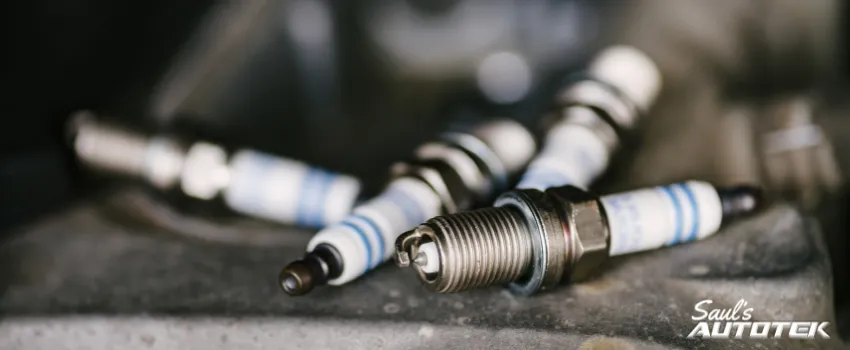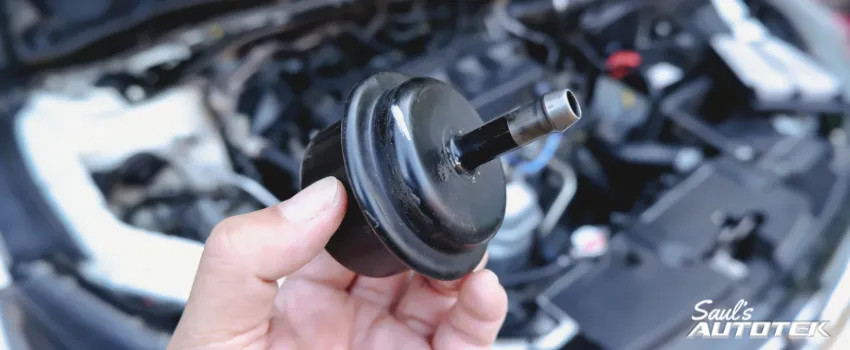Ensuring Your Vehicle & Tires Are Operating At Their Best In Colorado Winters

Hey there folks. I’m Saul Reisman here at Saul’s AUTOTEK, and today we’re going to talk a little bit about winter tires, what you can do to make yours operate as best as possible and the small differences and how they affect the way your vehicle handles safely.
First and foremost, any vehicle that’s going to be operated in extended snowy driving conditions should be equipped with a tire with an M and S mud and snow rating on the side of the tire, which looks like a small triangle with an M and S plus sign within it. That’s an indicator that this tire was designed to operate in conditions below 40 degrees for an extended period of time and has a harder tread compound so that it can withstand those conditions without giving up the tire strength and longevity. Most summer tires or racing tires and even most all-terrain tires do not come with this designation. So make sure you ask if you’re purchasing a new set of tires and you only plan on having one set to make it through the year, year-round, that it’s got that M and S designation. Especially being in Colorado where we have 300 days of sunshine plus a year, we know you’re going to make the most of those days of sunshine, but we want you prepared for those snowy days as well and that’s why it’s important to look for tires with that M/S designation on them.
However, one other thing we’re going to look at with tires is not just their tread compound, but how the tire pressure really affects them. A lot of folks here in the Denver metropolitan area where we’re located like to travel up to the weekend warrior status in the mountains and go skiing when they can or drive around the city looking at Christmas Lighting. This is a fantastic opportunity for them, it provides great tourism revenue for the state and additionally puts serious, serious use and abuse on their motor vehicles. We here at Saul’s AUTOTEK thank you for going skiing and keeping us in business. We appreciate it.
One step we can do to help keep you on the road and not seeing us all the time is to keep you safe. In terms of your tires, when you’re here at 5,000 feet approximately in elevation in the Denver metro area and you air up your tires to the manufacturer recommended stating, which typically it will be right here on the inside of the driver’s door. You air up your tires to this pressure setting and you typically won’t have any concerns. Most vehicles will have a sticker located right on the inside of the door stipulating, in this case, 29 pounds in the front and 36 in the rear, for the tires and the factory tire size it should be equipped with. It’ll additionally come with any spare information or weight information for the vehicle as needed so that those tires can be properly loaded and have that weight properly distributed while you’re driving down the road.
Now this BMW says to put the front tires at 29 and the rear at 36, and that’s here at 5,000 feet in elevation. If you drive this vehicle to Vale, which means you go through the Eisenhower Tunnel at 11,000 plus feet over Vail pass at 10,000 plus feet and then drop into Vail at approximately 8,000 feet, you’ve gone up and down over 15,000 vertical feet. And for every thousand feet change in elevation, there’s a 3% change in the air pressure on the planet. So as a result, the tire is sealed. So when you go up in elevation and the atmospheric pressure is effectively lower, it makes it appear as if the tire pressure is effectively higher. Now when you return back to a lower elevation and the air pressure here is effectively higher, that ratio still applies to it. However, your tire is selectively permeable and air pressure can and does, in fact, pass through it through serious elevation changes.
So if you start your day here in Denver, you drive to Vail, ski for the day, maybe the weekend, and come back down the next day, your tires have gone up in pressure and then they have come back down, but they might not have come back down as far as they typically would. So if this vehicle had the tires at 29 in the front when it left, they might show 35 in Vail. And when it comes back to Denver, they might show 32. Now, this might not seem like a huge change, but if you go skiing every weekend, that means that at the end of a month your tires might be 10 pounds overinflated compared to where they started with. You need to be checking your tires and checking those systems regularly.
Now you’ve heard us talk a little bit about ADAS and how those systems are designed to protect you. One of those is those TPMS systems. However, TPMS systems only work one direction. They’re only currently designed to protect you from a low-pressure situation, not a high-pressure situation. This means if you have a flat tire, the TPMS system will be able to detect that. However, if you have an overinflated tire that can equally cause tire problems heating up at the tire, improper wear of the tire, cupping and serious degradation of it that may lead to handling issues or a high-speed blowout, the computer system will have absolutely no idea. And now that we have these tire pressure monitoring systems, you would think by the name that that means the system is monitoring the tires and you don’t need to. The reality is you absolutely still need to be checking your tires or stopping in at Saul’s AUTOTEK where we do that as a courtesy service for free anytime we see your vehicle.
So if you’re going to be driving up and down in the wintertime in higher or lower elevations, please check your tires frequently. What may seem like a small difference is keeping you on the road, keeping you safe and giving you the ability to start, steer and stop consistently and safely. We here at Saul’s AUTOTEK offer a service twice a year to do tires exchanges. We know that many owners have opted to purchase a dedicated set of winter tires and a dedicated set of summer tires and we want to support them in every way we can as this truly gives you the best opportunity to have the best traction on your vehicle at all times. While an altering tire is a great middle of the road alternative to fit the budget, it’s not always the best for all traction situations. So here at Saul’s AUTOTEK at one day in the fall and one day in the spring, we dedicate our entire staff to just doing tire services.
Rather than going and waiting at the tire store last minute, when you see the weather forecast call for snow, spending money on new set of tires and waiting all day to get them with a hundred other people, come and see us on a scheduled planned day where we’ll give you a discount for getting it taken care of early and we’ll swap out your summer or winter back and forth. Making sure to take care of everything including tire mounting, balancing, and alignment. We even offer storage for your other set of tires if you don’t want to take them home and put them in the trunk of your car.
Give us a shout here at Saul’s AUTOTEK. We’ll keep your tires where they need to be. We’ll keep you on the road and make sure you get the longest life out of what’s keeping you safe. Talk to you soon. Stay on the road.
Schedule Your FREE diagnostic Subaru Outback Auto Repair Upkeep and Repair Appointment
Check out Our Reviews On Yelp! And Leave A Great One For Us!
Join Our Conversation on Facebook
Explore Our Exceptional Denver Auto Repair Services
- Brake Repair Service
- Suspension Repair
- Steering Repair
- Engine Repair
- Automotive Air Conditioning and Heating Repair





